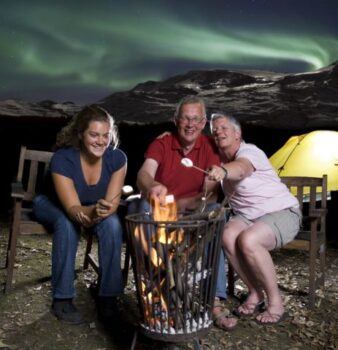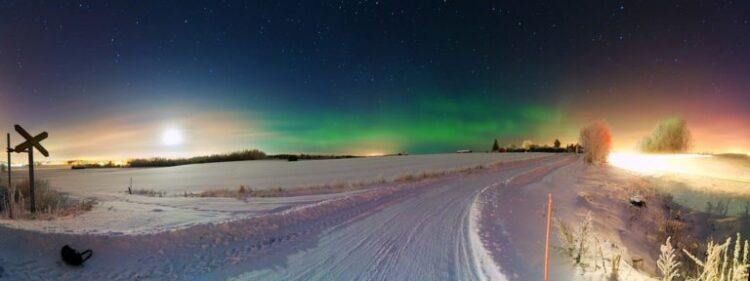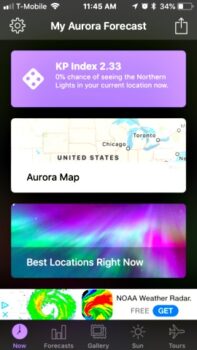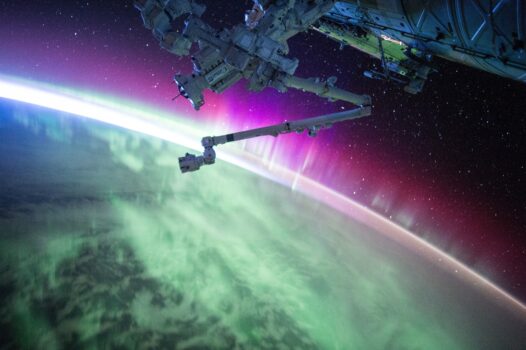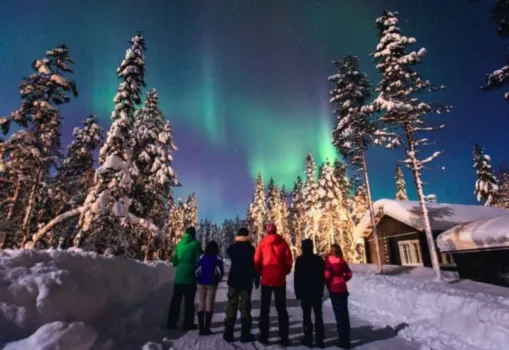
I’ve been wanting to go see the Aurora Borealis for years!
Aurora Borealis (also known as the Northern Lights) is a spectacular light show that happens when electrically charged particles traveling toward us from the sun enter our atmosphere and react with oxygen, nitrogen, and other gases.
The Northern Lights concentrate near Earth’s northern magnetic pole.
A similar phenomenon occurs toward the southern pole that is called the Aurora Australis (or Southern Lights).
Our naked eye can most easily see the green-yellow part of the spectrum where the sun emits most of its light. Green is the most common color observed but the Northern Lights can also appear white-gray. And a cloudy night if you’ve never seen them before, you might not even be entirely sure of what you’re looking at.
– Source
It’s On My Bucket List… Is It On Yours?
Seeing nature’s dazzling light show called Aurora Borealis has been a lifetime dream of mine.
I live in Florida, which is too far south to see the Northern Lights on a regular occasion.
The last time I saw the Aurora Borealis in Florida was in 1989 — during an extremely strong geomagnetic storm in which the magnitude of the Northern Lights intensified to where they were visible at points as far south as Honduras!
While the Aurora Borealis is normally only visible in northern places like Alaska and Canada, every once in a while the Northern Lights can be seen farther south.
Where To See Aurora Borealis
If you want a good chance at seeing the Aurora Borealis, you definitely want to head north — way north.
To dramatically improve your odds of seeing the Northern Lights, you’d want to plan a trip to the northernmost place in the U.S. — Alaska (year round, with peak viewing from late September to late March).
Or travel to Canada (year round, with peak viewing from December to March).
Generally speaking, most times of the year, the best place to see the Aurora Borealis is in a belt about 1,500 to 2,000 miles away from the magnetic north pole.
Of course, you don’t always have to go to the hinterlands of northern Canada or upper Arctic Circle reaches of Alaska to catch a glimpse of the Northern Lights.
A few times each year, the Aurora Borealis can also be seen in these parts of the United States:
- Glacier National Park in Montana – near the end of spring
- Cook County in the northeast corner of Minnesota – from late fall to early spring
- Headlands International Dark Sky Park near Mackinaw City in the Upper Peninsula of Michigan – between August and April (peak months are October, November, and April)
- Grand Fork in North Dakota – in spring and fall
- Priest Lake or the Idaho Dark Sky Reserve in the northern panhandle of Idaho – during the fall and spring
- Aroostook National Wildlife Refuge in Maine – during the winter months
The 4 most important factors that influence where and when the Northern Lights will be seen are:
- Magnetic latitude — find your magnetic latitude here
- Low light pollution in the area — including light from nearby cities and the moon
- Geomagnetic activity in the area — the degree of disturbance of the Earth’s magnetic field at the time, which is triggered by solar storms. (When activity is high, the Northern Lights are bright)
- An unobstructed view of the night sky — which is why Dark Sky Parks are ideal.
Best Time To See Northern Lights
The Northern Lights can be seen only at night. When present, you can see the lights starting 1 hour after sunset up to an 1 before sunrise.
The time between 6PM and 4AM is the most intense period of the day. The highest probability within this timespan is between 10PM and 11PM. However, this is a guideline, and during the Polar night auroras can be observed as early as 4PM, and all through the night. In periods of strong activity, one can expect several flares starting at around 6PM, peaking around 10PM, and going on until 1AM.
– Source
Many Aurora Borealis experts say the best time to plan a trip is during the months of September through March — when the nights are long and dark in the northern reaches of the world.
TIP: Near the top of the world, summer nights stay bright around the clock for several weeks, thus minimizing your chances of seeing the Aurora Borealis.
If you’re trying to avoid the snow and ice, September and October are usually the best times to plan a trip to see the Northern Lights. By November, snow storms are usually sweeping through and this means there’s a greater chance of cloud cover which — as you guessed — will obscure your view of the Aurora Borealis.
December, January, February, and March bring some of the longest, coldest nights of the year. Long nights are a definite plus, and some believe the cold weather may also increase your odds of seeing the Northern Lights.
How Weather Affects The Aurora Borealis
The only problem with planning a trip to see the Aurora Borealis is that the Northern Lights are extremely unpredictable.
Unlike, say a solar eclipse (which I planned for months to see in 2017 and am planning to see again in 2024), you can’t necessarily know the exact time, date, and location when you’ll be able to see the Aurora Borealis many days, weeks, or months into the future.
In fact, some would say you really can’t predict the appearance of the Northern Lights any more than just a few hours out! That’s because the weather has an affect on geomagnetic activity in the area. (The degree of disturbance of the Earth’s magnetic field at the time, which is triggered by solar storms.)
A geomagnetic storm is a major disturbance of Earth’s magnetosphere that occurs when there is a very efficient exchange of energy from the solar wind into the space environment surrounding Earth. These storms result from variations in the solar wind that produces major changes in the currents, plasmas, and fields in Earth’s magnetosphere. The solar wind conditions that are effective for creating geomagnetic storms are sustained (for several to many hours) periods of high-speed solar wind, and most importantly, a southward directed solar wind magnetic field (opposite the direction of Earth’s field) at the dayside of the magnetosphere. This condition is effective for transferring energy from the solar wind into Earth’s magnetosphere.
– Source
When geomagnetic activity is high, the Northern Lights are brighter.
The Best Northern Lights App
There are some great apps that can help you figure out where the Northern Lights are and when best to see them.
Some even predict the Northern Lights — or at least attempt to with the best scientific tools available.
My favorite Aurora Borealis app (the one I have on my phone) is simply called Aurora — it’s so easy to use, yet it’s packed with the following info that’s constantly updated:
- Northern Lights forecasts – so you’ll know when to watch the skies
- KP index – how strong the Aurora Borealis is (Here’s what the numbers mean.)
- Maps – showing where the Northern Lights can be seen
- Current solar activity – crucial in predicting the Aurora Borealis
- Best locations to see the Northern Lights – at any given moment
- Alerts – be notified whenever you’re in a place that may have view of the Aurora Borealis
Here are 6 other apps and websites to help you make the most of your Northern Lights trip:
- Service Aurora — a website with hourly Aurora Borealis updates
- AuroraCast — an app with Aurora Borealis forecasts, KP indices, light pollution maps, and more
- University of Alaska Aurora Forecast — a website with a visual map of where the Aurora Borealis can be seen
- Northern Lights Alerts — an app with real-time Aurora Borealis info and, plus alerts on where & when to see the lights
- NOAA Space Weather Prediction Center — a 3-day Northern Lights forecast on the National Oceanic & Atmospheric Administration website
- The Aurora Hunter — a website with all things Aurora, including a neat history on sunspot activity (which factors into how & when the Northern Lights occur)
Surprising Facts About The Aurora Borealis
In addition to the links I’ve included above, here are some other resources to help learn more about the Aurora Borealis and plan your Northern Lights trip:
- What Causes The Aurora Borealis — solar winds stream away from the sun at speeds of 1 million mph. When they reach the Earth (40 hours after leaving the sun), they follow the lines of magnetic force generated by the Earth’s core and flow through the magnetosphere — a teardrop-shaped area of highly charged electrical and magnetic fields!
- 5 Things No One Ever Tells You About The Northern Lights — like ‘Don’t go for the Northern Lights, go for the destination!’ and… ‘It takes a good bit of effort to see the Northern Lights.’
- Northern Lights Legends From Around The World — see how our forefathers believed the Aurora Borealis to be spirits… or gods… or celestial warriors.
- 8 Amazing Facts About The Aurora Borealis — like ‘Oxygen atoms emit green and sometimes red light, while nitrogen is more orange or red’ and…’Cameras are more sensitive than the human eye and can pick up even more spectacular shots than you witnessed in person.’

